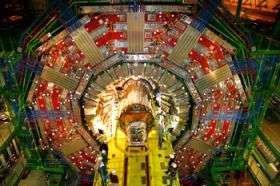CMS tracking detector successfully installed

Installation of the world’s largest silicon tracking detector was today successfully completed at CERN. In the early hours of Thursday 13 December the CMS Silicon Strip Tracking Detector began its journey from the main CERN site to the CMS experimental facility. Later that day it was lowered 90 metres into the CMS cavern. Installation began on Saturday 15 December and was concluded this morning.
“This achievement completes the installation of sub-detectors inside the CMS magnet, which was lowered into the cavern on 28 February,” said CMS technical coordinator Austin Ball. “It’s a big milestone for us.”
With a total surface area of 205 square metres, about the same as a singles tennis court, the CMS Silicon Strip Tracking Detector is by far the largest semiconductor silicon detector ever constructed. Its silicon sensors are patterned to provide a total of 10 million individual sensing strips, each of which is read out by one of 80,000 custom designed microelectronics chips. Data are then transported via 40,000 optical fibres into the CMS data acquisition system.
“The complete system operating at the LHC will produce data at a higher rate than the entire global telephone system,” said project manager Peter Sharp.
The silicon sensors are precision mounted onto 15,200 modules that are in turn mounted onto a very low mass carbon fibre structure that maintains the position of the sensors to less than the diameter of a human hair (100 microns).
“Each of the charged particles produced in LHC particle collisions at the heart of the CMS detector will be tracked with a precision of better than 20 microns,” said Sharp.
Final assembly of the silicon tracking detector began in December 2006 and was completed in March 2007. All of the systems were then fully commissioned, with 20% of the full detector operated over several months during which five million cosmic ray tracks were recorded. The results from these data were then rapidly analyzed using the CMS Grid-based distributed computing system. This commissioning demonstrated that the detector fully meets the experiment’s requirements.
“Constructing a scientific instrument of this size and complexity, designed to operate at the LHC without intervention for more than ten years, is a major engineering and scientific achievement,” said CMS spokesman Tejinder Virdee. “More than five hundred scientists and engineers from fifty-one research institutions world-wide have contributed to the success of the project.”
Institutions involved in the CMS tracker project are located in Austria, Belgium, CERN, Finland, France, Germany, Italy, Switzerland, the United Kingdom and the United States.
CMS is a worldwide collaboration comprising over 2500 scientists and engineers from 180 institutes in 38 countries and regions. These are Armenia, Austria, Belarus, Belgium, Brazil, Bulgaria, China, Colombia, Croatia, Cyprus, Estonia, Finland, France, Georgia, Germany, Greece, Hungary, India, Iran, Ireland, Italy, Korea, Lithuania, Mexico, New Zealand, Pakistan, Poland, Portugal, Russian Federation, Serbia, Spain, Switzerland, Taiwan, Turkey, Ukraine, United Kingdom, United States of America and Uzbekistan.
Source: CERN




















